Search results for: 'mit'
-
 Scarab with sphinx and Maat
Scarab with sphinx and MaatThe piece from the Ramesside period shows the goddess of truth and justice. Next to her is a name, probably that of pharao Mencheperre, who is famous as Thutmosis III.
Price: on request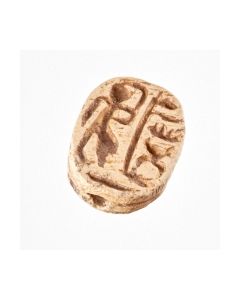 Scarab with cartouche
Scarab with cartoucheThe scarab from the late Ramesside period shows a standing person. A cartouche in front bears the name of pharao Mencheperre, who was famous as Thutmose III.
Price: on request Scarab with magic spell
Scarab with magic spellThe hieroglyphs are of the so called anra design, a magic spell in the ancient Egyptian belief. The scarab is from the 13th to 15th dynasty. It is described in the catalogue of Gautier-Vodoz.
Price: on request Scarab with geometric motive
Scarab with geometric motiveThe motive exhibits two symmetry axes and at least six triangles. A wonderful artistic expression of the highly evolved Egyptian maths. This scarab is described in the catalogue of Irène Gautier-Vodoz.
Price: on request Scaraboid from the Middle Kingdom
Scaraboid from the Middle KingdomThe stamp shows hieroglyphs with a title for the king of Upper and Lower Egypt. This scaraboid is described in the catalogue of Irène Gautier-Vodoz.
Price: on request Cowroid with Ankh and papyrus
Cowroid with Ankh and papyrusThe seal is engraved with the breath of life between two papyrus plants. This scaraboid is described in the catalogue of Irène Gautier-Vodoz.
Price: on request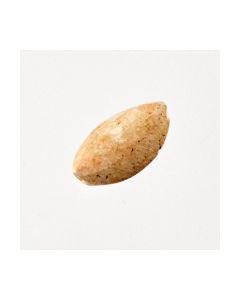 Cowroid with magic spell
Cowroid with magic spellThe hieroglyphs of the anra type are to be interpreted as magical formula. From the Second Intermediate Period of ancient Egpyt. This scaraboid is described in the catalogue of Gautier-Vodoz.
Price: on request Egyptian amulet of Shu
Egyptian amulet of ShuGod of the air and the sun. The highly stylized figurine shows the ancient Egyptian god on his knees, the arms raised towards the sun. From a British private museum.
Price: on request Egyptian amulet of Shu
Egyptian amulet of ShuGod of the air and the sun. The highly stylized figurine shows the ancient Egyptian god on his knees, the arms raised towards the sun. From a British private museum.
Price: on request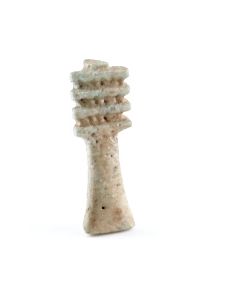 Djed pillar amulet
Djed pillar amuletÄgyptische Spätzeit, 26. bis 30. Dynastie. Mintgrüne Fayence. Der Djed-Pfeiler steht für Dauer und Beständigkeit und war im Alten Ägypten als Amulett sehr beliebt.
Price: on request Djed pillar amulet
Djed pillar amuletÄgyptische Spätzeit, 26. bis 30. Dynastie. Mintgrüne Fayence. Der Djed-Pfeiler steht für Dauer und Beständigkeit und war im Alten Ägypten als Amulett sehr beliebt.
Price: on request Djed pillar amulet
Djed pillar amuletÄgyptische Spätzeit, 26. bis 30. Dynastie. Mintgrüne Fayence. Der Djed-Pfeiler steht für Dauer und Beständigkeit und war im Alten Ägypten als Amulett sehr beliebt.
Price: on request Overseer shabti from 21st dynasty Egypt
Overseer shabti from 21st dynasty EgyptSpezielle ägyptische Totenfigur als Aufseher der Ushabti-Arbeiter in der Unterwelt. Typische Schürze und Peitsche in der rechten Hand. Statuette aus der 21. Dynastie des Alten Ägypten.
Price: on request Djed-Pfeiler als Amulett
Djed-Pfeiler als AmulettÄgyptische Spätzeit, 26. bis 30. Dynastie. Mintgrüne Fayence. Der Djed-Pfeiler steht für Dauer und Beständigkeit und war im Alten Ägypten als Amulett sehr beliebt.
Price: on request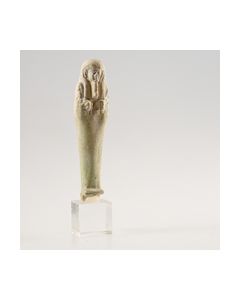 Ushebti des Wah-ib-Ra aus der Sammlung von Sir Flinders Petrie
Ushebti des Wah-ib-Ra aus der Sammlung von Sir Flinders PetrieInschrift: Osiris Wah-ib-ra, geboren von (Sohn der) Ta bzw. Tent-Pa. Exzellente Erhaltung, Hieroglyphen klar lesbar.
Price: on request Egyptian protective amulet and seal with Pataikos
Egyptian protective amulet and seal with PataikosDwarf god with knifes in his hands and Eye of Horus on his belly. The bottom side is made as a stamp seal with hieroglyphic inscription. Work of highest quality with fine details. Dating to the Third Intermediate Period.
Price: on request Großes koptisches Textilfragment
Großes koptisches TextilfragmentGroßes Fragment, 13cm x 11cm. Doppelter Zierstreifen und kreisförmiges, zweifarbiges Ornament. 5. - 7. Jh. n. Chr.
Price: on request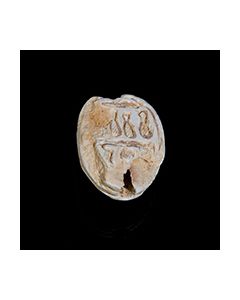 Ägyptischer Skarabäus
Ägyptischer SkarabäusSehr schön gearbeiteter Körper, ca 1000 v.Chr., 21. Dynastie, Dritte Zwischenzeit. Der Stempel ist in 2 Register geteilt. Das obere Register zeigt 3 Vasen, das untere ist teilweise beschädigt.
Price: on request Nordafrikanisches Beil aus Felsgestein
Nordafrikanisches Beil aus FelsgesteinPräzise gearbeitete polierte Flächen. Sehr schöner grau-grüner Stein. Neolithikum, ca. 6000 v. Chr. bis 2500 v. Chr.
Price: on request 4 Pfeilspitzen aus dem Neolithikum
4 Pfeilspitzen aus dem NeolithikumFunde aus der Region der steinzeitlichen Ounjougou-Kultur in Nordafrika, westliche Sahara. Ca. 5000 bis 3000 v.Chr, Neolithikum.
Price: on request Scarab with wishes
Scarab with wishesNice scarab made of dark steatite. The hieroglyphs could be read as New Year's wishes.
Price: on request Faience tile of the Djoser pyramid type
Faience tile of the Djoser pyramid typeEgyptian wall tile from the Old Kingdom, 2nd to 3rd dynasty. The tile type is known from the famous step pyramid of king Djoser.
Price: on request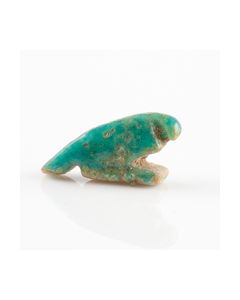 Ägyptisches Falkenamulett
Ägyptisches FalkenamulettKunstvolles Schmuckstück in Form eines Falken aus türkisfarbener Fayence. Spätzeit bis ptolemäische Zeit, Altes Ägypten, 664 v. Chr. bis 30 v. Chr.
Price: on request Egyptian pataikos
Egyptian pataikosGod or god-like dwarf. The figurine was supposed to have a magical protective function. 26th to 30th dynasty of Ancient Egypt. From a British private museum.
Price: on request Egyptian pataikos
Egyptian pataikosGod or god-like dwarf. The figurine was supposed to have a magical protective function. 26th to 30th dynasty of Ancient Egypt. From a British private museum.
Price: on request Egyptian faience figurine of the dwarf god pataikos
Egyptian faience figurine of the dwarf god pataikosThe figurine was supposed to have a magical protective function. 26th to 30th dynasty of Ancient Egypt. From a British private museum.
Price: on request 10 neolithische Pfeilspitzen inkl. Bestimmungsbuch
10 neolithische Pfeilspitzen inkl. BestimmungsbuchSonderangebot von 10 Pfeilspitzen aus Nordafrika, ca. 5000 bis 3000 v.Chr., und schwer erhältlichem Bestimmungsbuch von D. Greenwell. 7x verfügbar.
Price: on request Neolithische Steinpfeilspitzen der Ounjougou-Kultur
Neolithische Steinpfeilspitzen der Ounjougou-KulturOriginal Funde aus der Region der steinzeitlichen Ounjougou-Kultur in Nordafrika, westliche Sahara. Ca. 5000 bis 3000 v.Chr, Neolithikum.
Price: on request Scaraboid with Red Crowns of Lower Egypt
Scaraboid with Red Crowns of Lower EgyptThe hieroglyphs on the lower side symbolize the rule over Lower Egypt. The rising sun is symbolized above. This scaraboid is described in the catalogue of Irène Gautier-Vodoz.
Price: on request Scarab with inscription Amun Re
Scarab with inscription Amun ReInteresting scarab from the New Kingdom. With hieroglyphs reading Amun Re, main god of Theben, and lotus flower.
Price: on request Scarab with cross symbol
Scarab with cross symbolA piece from the Ramesside Period to the early Third Intermediate Period of ancient Egypt. Great early 20th century provenance.
Price: on request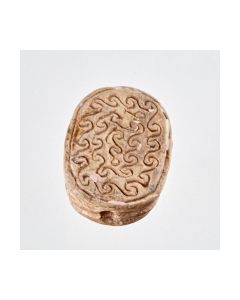 Scarab with spiral design and symbol for good luck
Scarab with spiral design and symbol for good luckThe Egyptian scarab from the Second Intermediate Period is decorated with a geometrical pattern. A nefer hieroglyph stands for good luck.
Price: on request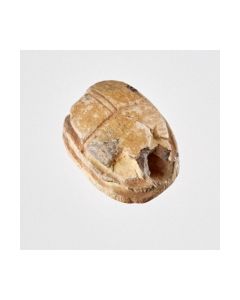 Egyptian Scarab with hieroglyphs
Egyptian Scarab with hieroglyphsInteresting scarab made of steatit with inscription for Amun. Dating to the 19th to 21st dynasty of ancient Egypt.
Price: on request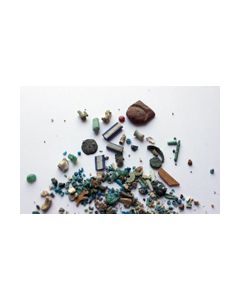 Restbestand - Fragmente ägyptischer Perlen und Amulette aus der Spätzeit
Restbestand - Fragmente ägyptischer Perlen und Amulette aus der SpätzeitGroßes Lot aus farbenfrohen Perlen und Amuletten. Ägypten, Spätzeit.Dabei auch 2 Münzen aus Bronze.
Price: on request Scarab from the Second Intermediate Period
Scarab from the Second Intermediate PeriodThe lower side shows a scarab, flanked by two uraeus snakes. 13th to 15th dynasty of ancient Egpyt. This scarab is described in the catalogue of Irène Gautier-Vodoz.
Price: on request Scarab with the Red Crown of Lower Egypt
Scarab with the Red Crown of Lower EgyptThe scene can be seen as worship of the Deshret, the symbol of the kings of Lower Egypt during Hyksos times. An interesting piece of evidence of the Hyksos rule over Egypt.
Price: on request

